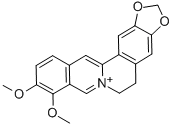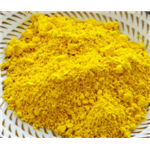Description
Coptis chinensis was widely used in China as a folk medicine by Shennong around
3000 BC. Coptis chinensis was firstly described in the ancient Chinese medical
book The Divine Farmer’s Herb-Root Classic. Coptis chinensis was used to treat
intestinal bacterial infections and antipyretic analgesic for thousands of years ago
Coptis chinensis also called zhilian, chuanlian, weilian, jizhualian, shanglian,
and xuanlian in Chinese history. Coptis chinensis was accepted by most physicians,
and the Chinese pharmacopoeia also uses Coptis chinensis as its official name .
Coptis chinensis mainly grows in Anhui, Hunan, Sichuan, and Yunnan and has been
cultivated in Sichuan since the Ming dynasty, which has a long history of cultivation. Other species of Coptis chinensis from different places were used as medicine.
However, commodity circulation of wild Rhizoma coptidis has not been formed .
Coptis chinensis is national three level protection plants at present and majorly produced in Shizhu of Chongqing, West Hubei, Shanxi, and Gansu.
Berberine is a quaternary ammonium salt from the protoberberine group of isoquinoline alkaloids. It is found in some plants such as huanglian 黄连 (Rhizoma
coptidis), huangbo黄柏 (Phellodendri Chinensis Cortex), sankezhen三颗针
(Berberidis Radix), and so on.
The components of Coptis chinensis which have antibacterial and antiinflammatory effects are original alkaloid berberine class, including berberine, coptisine, palmatine, epiberberine, columbamine, jatrorrhizine, worenine, and
magnoflorine, with berberine having the highest content (5–8%).
Chemical Properties
White to yellow crystals. Iinsoluble in water; soluble in ether, alcohol. Salts of berberine are berberine bisulfate, berberine sulfate, and berberine hydrochloride. All three are yellow crystals, slightly soluble in water.
Physical properties
Appearance: Berberine is odorless and yellow crystalline powder. Solubility:
Berberine is soluble in hot water, slightly soluble in water or ethanol and in chloroform, and insoluble in ether. Melting point: Melting point of berberine is about
204–206?°C.?Berberine is heat labile.
History
Berberine is often used in the form of quaternary ammonium alkali. The solubility of berberine in water is lower, for example, berberine hydrochloride is 1:500, and berberine sulfate is 1:30. In 1926, berberine was first separated from bark of Zanthoxylum clava. Modern pharmacology study showed that berberine has defined structure and is a monomer of traditional Chinese medicine. Berberine can be obtained from many sources and is used in clinics, with reliable pharmacological effects and various and unique mechanisms.
At present, berberine can be synthesized by industrial biosynthesis. A series of derivatives can also be synthesized by structure modification, and the pharmacological activities of these derivatives have been tested.
Uses
Antiseptic drug.Treat intestinal infection caused from dysentery bacillus and E.coil
Definition
ChEBI: Berberine is an organic heteropentacyclic compound, an alkaloid antibiotic, a botanical anti-fungal agent and a berberine alkaloid. It has a role as an antilipemic drug, a hypoglycemic agent, an antioxidant, a potassium channel blocker, an antineoplastic agent, an EC 1.1.1.21 (aldehyde reductase) inhibitor, an EC 1.1.1.141 [15-hydroxyprostaglandin dehydrogenase (NAD(+))] inhibitor, an EC 1.13.11.52 (indoleamine 2,3-dioxygenase) inhibitor, an EC 1.21.3.3 (reticuline oxidase) inhibitor, an EC 2.1.1.116 [3'-hydroxy-N-methyl-(S)-coclaurine 4'-O-methyltransferase] inhibitor, an EC 3.1.1.4 (phospholipase A2) inhibitor, an EC 3.4.21.26 (prolyl oligopeptidase) inhibitor, an EC 3.4.14.5 (dipeptidyl-peptidase IV) inhibitor, an EC 3.1.3.48 (protein-tyrosine-phosphatase) inhibitor, an EC 3.1.1.7 (acetylcholinesterase) inhibitor, an EC 3.1.1.8 (cholinesterase) inhibitor, an EC 2.7.11.10 (IkappaB kinase) inhibitor, an EC 2.1.1.122 [(S)-tetrahydroprotoberberine N-methyltransferase] inhibitor, a geroprotector and a metabolite.
brand name
3 p maid;Berberal;Berberil;Detal;Kenmin-s;Kinosin s;Phelloverin a;Tangenin;Thalsin.
World Health Organization (WHO)
Berberine, an alkaloid contained in many plants including
Berberis species, remains available in many tropical countries. Both traditional
herbal remedies and tablet formulations containing this substance have been used
in the treatment of gastrointestinal disease, and injectable preparations have been
claimed to be of value in the treatment of cutaneous leishmaniasis. The action
taken in Singapore relates to reports of jaundice, haemolytic anaemia and
kernicterus with brain damage in infants with G6PD deficiency who were exposed
either in utero or post-natally. Preparations for topical application are also
available in some countries. These have not been associated with reports of
systemic toxicity.
Hazard
Toxic via ingestion, inhalation, skin absorption.
Pharmacology
Berberine hydrochloride has extensive pharmacological effects, such as antibacterial, antiviral, anti-inflammatory, analgesic, anticancer, hyperglycemic, antilipidemic, antihypertension, anti-arrhythmic, anti-heart failure, and so on. Experimental study and clinical reports demonstrate that berberine has therapeutic effect on the endocrine system, circulatory system, nervous system, digestive system, and respiratory system and other diseases.
The clinical indication of berberine is intestinal bacterial infectious diarrhea, which is confirmed by years of clinical application. Berberine hydrochloride exerts effect on intestinal infection, eye conjunctivitis, and suppurative otitis media induced by Shigella dysenteriae, Escherichia coli, and Staphylococcus aureus and ameliorates gastritis and combined gastric and duodenal ulcers. Berberine hydrochloride also has curative effect on acute lung injury, pneumonia, and other respiratory diseases; peptic ulcer, colitis, and other digestive system diseases; pregnancy, urinary, and reproductive system infections; and other urinary tract and reproductive system diseases.
Clinical Use
Rhizoma coptidis, as the digestive tract disease medication, has a history of more
than 3000?years in China and India. Berberine, as a cathartic nonprescription drug,
is mainly used in the treatment of intestinal infection clinically. Clinical research
showed that berberine has hypoglycemic effect and has very good prevention and
treatment for diabetic patients with complications such as hypertension, hyperlipidemia, thrombosis, and inflammation
There are few oral side effects of berberine hydrochloride, accidentally appears
nausea, vomiting, rash, and fever, which can disappear after withdrawal of drug. In
patients with hemolytic anemia and lack of glucose-6-phosphate dehydrogenase, it
was forbidden to be used. Berberine if used intravenously is toxic, but is only suitable for oral drug delivery .
Safety Profile
An alkaloid poison by ingestionand subcutaneous routes. In humans, toxic doses lowerthe body temperature, increase peristalsis, and cause deathby central paralysis. Mutation data reported. Should carry apoison label. Should never be ingested without t
Purification Methods
Berberine crystallises from pet ether or ether as yellow needles or from H2O. [Beilstein 27 II 567, 27 III/IV 6539.]




